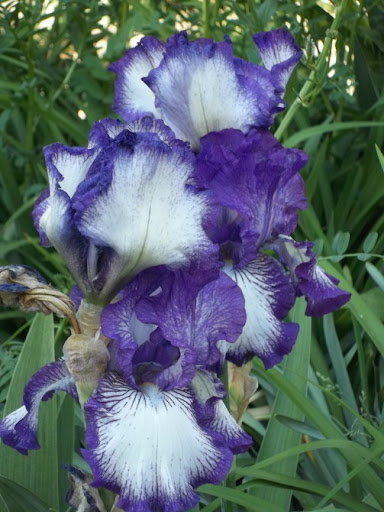(To celebrate passing the ninety-day milestone with this blog, Annake answers some reader's questions that have accumulated...)
Q: Why did you choose the name Annake for yourself and your business?
A: Annake is what my Frisian grandmother called me when I was a little girl. My middle name is Anna, in honor of my grandmother's only daughter, who died long before I was born. My grandmother was my foremost role model.
 |
| A Bi-colored Iris from the Garden |
Not quite five feet tall and weighing less than a hundred pounds, she had an indomitable spirit. As a young woman, she left her home on the western edge of the Jutland Peninsula, crossed the Atlantic Ocean to America in steerage (below decks on a ship), traveled across half the United States by train to Davenport, Iowa --- all to marry a man she had never met. She was a respected midwife who delivered scores of babies, including six of her own. More than a hundred of them --- black, brown, red and white --- came to celebrate her eightieth birthday with her.
She was an accomplished cook and an expert needlewoman. Although she was severely crippled by arthritis by the time she reached middle age, she continued to knit, crochet, quilt, and embroider into her mid-eighties. Sadly, she outlived all of her family except my father, another niece, and myself. Still she never lost her grit, determination, or sense of humor. She will always be my guiding star.
Q: Why do you use the orange daylilies as a background for your blog? Didn't you say that irises are your favorite flower?
A: Do you mean besides the fact that our daylilies produce so many new bulbs each year that we give away a wheelbarrow load every summer?
 |
| Daylily Latch Hooked Rug |
Actually, this goes back to a time when I was teaching fifth graders about Georgia O’Keeffe. I made several oversized flower pictures in various media show the students, along with samples of O’Keeffe work, before I asked them to make their own large flower pictures. Their favorite was a study in pastels and crayon of an orange daylily. Several students asked me to make computer copies of the picture for them. I did that, filed the picture, and essentially forgot about it.
After I retired, I cleaned out my files and came across the original drawing. I decided to make a rug, using the picture as a basis for my design. It was the first rug I sold. The lady who bought it was horrified at the thought of putting it on the floor and walking on it. She said she didn't know what she was going to do with it but she had to have it. That's the kind of customer I like!
 |
| Day-Glo Daylily Needlepoint |
I've also done a daylily as a large needlepoint. The colors came from my imagination; however, I see one in this year's catalogs that comes very close to my imaginary one. Is art imitating life or is life imitating art?
 |
| Red Iris from the Garden |
Yes, I did say irises are my favorite flower. I can hardly wait for this year's blooms! Incidentally, another of the examples I did for the O’Keeffe project, a pink cut-paper iris, became the basis for still another rug. (See the photo at the bottom of the page.) I'm glad I didn't throw those samples away.
Q: You have shown several works in progress on your blog. Will we get to see them again when they are completed?
 |
| Iris Needlepoint, Completed and Framed |
A: Yes, indeed. They can be seen on our Etsy shop site, of course, but I also plan to use some to illustrate future posts. The framed iris needlepoint I was working on in the February 12th post is shown here today. The wall hanging shown in progress on the February 28th post is in the blocking and backing stages now and will be shown soon. You can see the jewelry being made by another of our artisans on the April3rd post, along with much of her other work, on our shop site currently.
Q: Does the Gnome really live under your garden? (This is from a child.)
A. No, dear, he was only teasing you. The ground would be much too hard and cold to live under in the wintertime. Actually, the Gnome lives under our house.
I really enjoy your questions. Ask away!
Annake
 |
| Iris Latch Hooked Rug |





